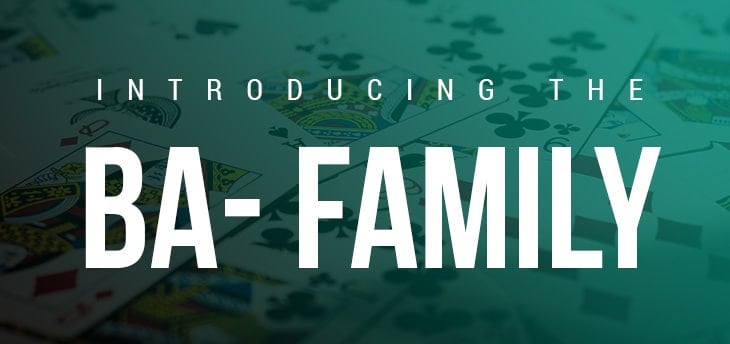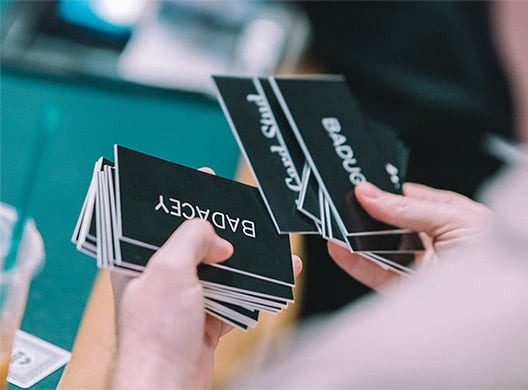Introducing the Ba- family. Dugi, Duecy, and Dacy

Badugi, Badeucy, and Badacy
If you’ve only played Texas Hold’em for your entire poker career, you’re missing out. Different poker variants can provide a breath of fresh air from Hold’em, sporting all-new mechanics, and rules. Who knows, maybe you’ll even like variants like Omaha more than Hold’em if you give them a try!
Now, if the most popular Hold’em alternatives like Omaha and Razz failed to tickle your fancy, maybe you need something more exotic. Today, we’ll cover a unique form of poker from South Korea: Badugi. We’ll also go into its two main variants: Badeucy and Badacy.
Badugi Origins
Badugi most likely originated from South Korea, with the name roughly translating to “black and white spotted dog.” Its origins have been debated, as while the general consensus is that it’s been played in Korea since the 80s, some claim that a variant similar to Badugi was played in Canada under the name “Off Suit Lowball.”
It started gaining popularity after being introduced online in late 2008. In 2009, Badugi was added to the list of games for the WCOOP (World Championship of Online Poker) tournament series.
Badugi has even been added as an event at the World Series of Poker (WSOP). It was previously part of the Dealer’s Choice and Triple Draw Mix events and now, has its own $1,500 event at the 2023 WSOP.

Badugi Breakdown
Badugi is a triple-draw, lowball form of poker with four-card hands. Let’s analyze that complex terminology piece by piece.
The ‘draw’ part of the name describes the basic outline of play, similar to community card or stud games. Community card games have shared cards everyone can use, like in Hold’em, while stud games give players individual mixes of face-down and face-up cards. Draw games allow players to exchange their cards for new ones.
After players are dealt a complete hand, and betting occurs, a “draw” round happens where the players can exchange any quantity of their cards for an equivalent amount of cards from the deck. Triple-draw means there are three of these “draw” rounds.
Lowball describes a form of poker with inverted hand rankings. Traditional poker’s “best” hands become the worst in lowball, and vice versa. Badugi’s hand rankings are slightly different from most forms of lowball since a players hand contains only four cards. Straights and flushes are not counted, and aces are always considered low, below the two in value.
The best hand is known as the “Badugi.” This is a four-card hand where no cards share a suit or a rank. If two players have a Badugi, the one with the lowest high card wins. This makes the best possible Badugi 4-3-2-A.
A hand with one pair or two cards of the same suit is a “three-card Badugi.” For hands with a common suit, only the lowest card of that suit counts. For example, Jc-6c-3s-2d is a “6-3-2” three-card six.
Badugis always win against three-card hands regardless of the card rankings, and the three-card hands always win against two-card ones.
During a tie, the second-highest card determines the winner, then the third-highest if the second-highest cards are equal, and so on. Any cards that are ignored because of a shared suit or rank aren’t considered when deciding a tie.

The flow of Badugi: Round by round
Badugi uses blinds, similar to Texas Hold’em and many other forms of poker. These are forced bets assigned to two of the players every hand, guaranteeing money in the pot and discouraging conservative play. The two blinds are the big and small blind, with the small blind being half the big one.
The first betting round in Badugi begins after everyone is dealt four cards face-down. Then, standard betting action begins to the right of the big blind, giving players the chance to call, raise, or fold. After the first betting round, players go through the first draw round, where they can draw new cards or keep their hand.
The second betting round occurs after the draw round is over, then the second draw round occurs. This process repeats one more time for a total of three draw rounds and four betting rounds.
Badugi is mainly played as either a fixed-limit game with only two possible bet sizes, a half-limit game where the maximum bet size is half the current pot or a pot-limit game where the maximum bet size equals the pot. The betting format significantly changes strategy, so be sure to understand which kind of Badugi you’re playing.

Badeucy
“Badeucy” is a variation on Badugi. It is a portmanteau of Badugi and Deuce-to-seven lowball. Deuce-to-seven, also known as 2-7 Lowball, is a lowball game with different hand rankings from Badugi.
It considers straights and flushes as exceptionally weak hands. Additionally, aces are always considered high. Thus, the best hand in 2-7 Lowball is 7-5-4-3-2. Aces aren’t below twos, and a 6-5-4-3-2 hand would be a straight. While it does penalize flushes, 2-7 Lowball doesn’t care about suits like Badugi; a 7-5-4-3-2 where four cards are diamonds is perfectly fine.
Badeucy uses a split pot system. Half the pot is given to the player with the best Badugi hand while the other half is given to the player with the best hand according to 2-7 Lowball rules. Aces are always considered high, so the best Badugi in Badeucy would be 5-4-3-2.
Players are dealt five cards and can use any four cards to make a Badugi. The extra card, along with the potential to draw, means making a Badugi is easier; likewise, the average Badugi is stronger.
Badacy
Finally, we have Badacy, another Badugi variant that combines Badugi and another form of lowball. It uses Ace-to-five low, which is very similar to regular Badugi rankings except with five cards. Ace-to-five low also doesn’t care about suits, similar to Deuce-to-seven low.
Aces are always considered low, so the best five-card hand would be 5-4-3-2-A. The best Badugi is also just 4-3-2-A of different suits, so it’s possible to have both the best Ace-to-five low hand and the best Badugi.
Badacy is slightly less popular than Badeucy but still worth learning since the two are almost always featured alongside each other in mixed-game events.
